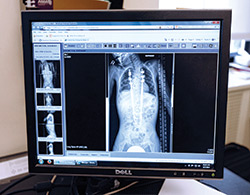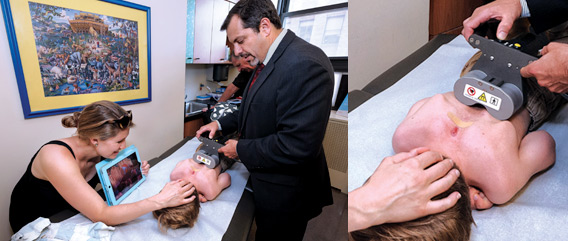Magnet Replaces the Scalpel for Treating Kids with Severe Spinal Deformities
Pediatric orthopedic surgeons at Columbia are using a new device with magnetic technology that avoids the need for multiple spine-lengthening surgeries to correct early-onset scoliosis, a severe curvature of the spine in young children.
In April, Michael Vitale, MD, the Ana Lucia Professor of Pediatric Orthopedic Surgery at CUMC and 1995 graduate of P&S, performed the first procedure in the New York area, using the device to treat a 5-year-old boy.
When braces and casts cannot control scoliosis in young children, surgeons turn to growing rods, which help correct the curve while allowing the spine to grow. When spinal maturity is near, the rods are removed and a spinal fusion can be performed.
But during years of treatment with growing rods, patients must undergo surgery every six months to lengthen the rods to keep up with the patients’ growth. A patient may undergo eight to 10 procedures, which are costly and result in lost time for parents at work and children at school.
The new device—MAGEC (MAGnetic Expansion Control) rods—contains a mechanism inside the growing rods that allows surgeons to lengthen the rods with a hand-held external magnet, without surgery.
 X-ray of the 6-year-old patient’s spine, showing growing rods in place
X-ray of the 6-year-old patient’s spine, showing growing rods in placeDr. Vitale expects this advance to improve outcomes in children with early-onset scoliosis in whom spinal curves exceed 40 degrees. Early-onset scoliosis accounts for about 10 percent of all children diagnosed with scoliosis. Left untreated, children with this condition are at risk for developing cardiac and/or respiratory problems related to stunted growth and development.
“This new approach is designed to remove the need for repeated trips to the operating room as well as eliminate complications from infections and psychosocial effects of multiple surgeries,” says Dr. Vitale.
Once the MAGEC rods are implanted, the rod-lengthening procedure, which takes approximately 15 minutes, is performed every three to six months.
The MAGEC system has been used successfully to treat more than 750 children in 24 countries. For the past five years, Dr. Vitale has been part of efforts to advocate for FDA approval of the device. In February 2014 the MAGEC system was cleared by the FDA for use in young patients with severe spinal deformities associated with, or at risk of, thoracic insufficiency syndrome.
- Log in to post comments


